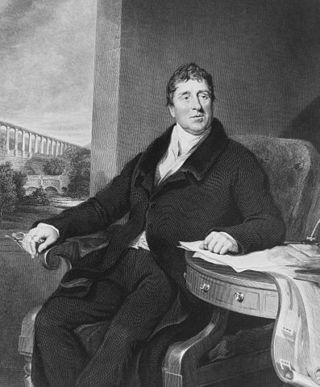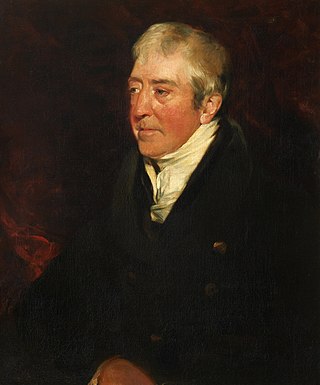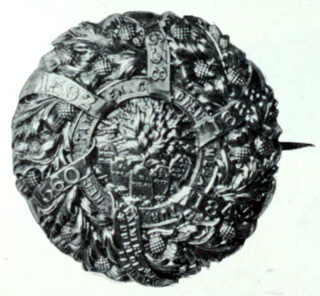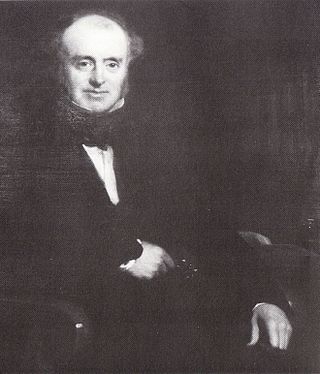!["Colonel George Turnbull and sergeant play a strathspey, 1770, New York" by James Waylen, 26x32inches, 1884. The text below includes the Colonel with a favorite sergeant, the solatium [compensation] of a strathspey after a weary day's work. The prostration of the regimental dog indicates the severity of the march, while the approach of the whisky induces the sergeant to beat time with encreased [stet] emphasis. Colonel George Turnbull -- James Waylen picture.jpg](http://upload.wikimedia.org/wikipedia/en/thumb/c/cd/Colonel_George_Turnbull_--_James_Waylen_picture.jpg/300px-Colonel_George_Turnbull_--_James_Waylen_picture.jpg)
James Waylen (1810-1894) in his 20s was already successful as an artist when he exhibited two portraits and a work entitled Marmion Borne Down by the Scottish Spearmen at Flodden at the Royal Academy of Arts in London in 1834 to 1838. [3]
!["Colonel George Turnbull and sergeant play a strathspey, 1770, New York" by James Waylen, 26x32inches, 1884. The text below includes the Colonel with a favorite sergeant, the solatium [compensation] of a strathspey after a weary day's work. The prostration of the regimental dog indicates the severity of the march, while the approach of the whisky induces the sergeant to beat time with encreased [stet] emphasis. Colonel George Turnbull -- James Waylen picture.jpg](http://upload.wikimedia.org/wikipedia/en/thumb/c/cd/Colonel_George_Turnbull_--_James_Waylen_picture.jpg/300px-Colonel_George_Turnbull_--_James_Waylen_picture.jpg)
James Waylen (1810-1894) in his 20s was already successful as an artist when he exhibited two portraits and a work entitled Marmion Borne Down by the Scottish Spearmen at Flodden at the Royal Academy of Arts in London in 1834 to 1838. [3]
He was born in Devizes, Wiltshire in southern England on 19 April 1810 of Robert and Sarah Waylen. [4] He on 2nd June 1829 came to the office [of the famous civil engineer Thomas Telford, designing London's St Katharine Docks]. [5] [6]
Working in Telford's drawing office, he made long-life friends with another civil engineer the Scottish George Turnbull who in 1838 asked Waylen to travel from London to Huntingtower near Perth in Scotland to paint a portrait in oils of Turnbull's father William Turnbull who wrote to his son:
Waylen seems just the same unassuming, kindhearted creature as when last here: his heart appears to be in his profession, and he has made more progress in it than could have been expected in the time; we find him very amusing in the accounts of his travels. He has been here more than a week and has made a success in making a likeness of me: everyone who sees it says the likeness is striking. [7]
.
Waylen seems to have had a long artistic career in that he in about 1868 was commissioned by Turnbull to paint Turnbull's three children together. Yet later, in 1884, Waylen as a present to Turnbull painted Turnbull's great uncle Colonel George Turnbull.

Thomas Telford was a Scottish civil engineer. After establishing himself as an engineer of road and canal projects in Shropshire, he designed numerous infrastructure projects in his native Scotland, as well as harbours and tunnels. Such was his reputation as a prolific designer of highways and related bridges, he was dubbed the Colossus of Roads, and, reflecting his command of all types of civil engineering in the early 19th century, he was elected as the first president of the Institution of Civil Engineers, a post he held for 14 years until his death.

Alexander Nasmyth was a Scottish portrait and landscape painter, a pupil of Allan Ramsay. He also undertook several architectural commissions.

The Disruption of 1843, also known as the Great Disruption, was a schism in 1843 in which 450 evangelical ministers broke away from the Church of Scotland to form the Free Church of Scotland. The main conflict was over whether the Church of Scotland or the British Government had the power to control clerical positions and benefits. The Disruption came at the end of a bitter conflict within the Church of Scotland, and had major effects in the church and upon Scottish civic life.

John Rickman was an English government official and statistician of the early nineteenth century.

Huntingtower Castle, once known as Ruthven Castle or the Place of Ruthven, is located near the village of Huntingtower beside the A85 and near the A9, about 5 km NW of the centre of Perth, Perth and Kinross, in central Scotland, on the main road to Crieff. This castle is the subject for several local ghostlore stories.

James Walker was an influential British civil engineer and contractor.

Huntingtower and Ruthvenfield is a village in Perthshire, Scotland, on the River Almond, 3 miles northwest of Perth.

Norman Macleod was a Scottish clergyman and author who served as Moderator of the General Assembly of the Church of Scotland in 1869/70.

Abbots Langley is a large village and civil parish in the English county of Hertfordshire. It is an old settlement and is mentioned in the Domesday Book. Economically the village is closely linked to Watford and was formerly part of the Watford Rural District. Since 1974 it has been included in the Three Rivers district.

Sir Daniel Macnee FRSE PRSA LLD, was a Scottish portrait painter who served as president of the Royal Scottish Academy (1876).

Brigadier-General Sir Alexander Gibb was a Scottish civil engineer. After serving as Civil Engineer-in-Chief to the Admiralty and Director-General of Civil Engineering at the Ministry of Transport, he established the engineering consultancy firm Sir Alexander Gibb & Partners.

James Abernethy FRSE MICE was a Scottish civil engineer.

The East Indian Railway Company, operating as the East Indian Railway, introduced railways to East India and North India, while the Companies such as the Great Indian Peninsula Railway, South Indian Railway, Bombay, Baroda and Central India Railway and the North-Western Railway operated in other parts of India. The company was established on 1 June 1845 in London by a deed of settlement with a capital of £4,000,000, largely raised in London.

George Turnbull was the Scottish engineer responsible from 1851 to 1863 for the construction of the first Indian long-distance railway line: Calcutta to Benares up beside the Ganges river, 541 miles, . The main line was later extended to Delhi. He had some 100 British civil engineers and 118,000 Indian workers. All railway lines, engines etc etc were brought from Britain in ships -- most then went in Indian ships up the Ganges river, despite monsoons.

George Turnbull was a Scottish American soldier and settler in New York City.

Koilwar Bridge, at Koilwar in Bhojpur spans the Sone river. This 1.44 km long, 2-lane wide rail-cum-road bridge connects Arrah with Patna, the capital of Bihar state in India. The bridge is named after Indian academic and social reformer Prof. Abdul Bari, and is presently the oldest operational railway bridge in India standing since 4 November 1862. It is shown in the 1982 Oscar award winning film Gandhi, directed by Richard Attenborough. From 1862 to 1900, Koilwar bridge remained as the longest river bridge in India.

Hector Turnbull was a leading Perthshire linen bleachfield developer and operator.

Folkestone Harbour is the main harbour of the town of Folkestone in Kent, England.
Francis Whishaw was an English civil engineer. He was known for his role in the Society of Arts, and as a writer on railways. Later in life he was a promoter of telegraph companies.
Events from the year 1819 in Scotland.